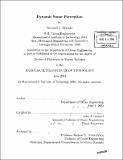| dc.contributor.advisor | John J. Leonard. | en_US |
| dc.contributor.author | Rikoski, Richard J | en_US |
| dc.contributor.other | Massachusetts Institute of Technology. Dept. of Ocean Engineering. | en_US |
| dc.date.accessioned | 2007-01-10T21:01:59Z | |
| dc.date.available | 2007-01-10T21:01:59Z | |
| dc.date.copyright | 2003 | en_US |
| dc.date.issued | 2003 | en_US |
| dc.identifier.uri | http://hdl.handle.net/1721.1/35702 | |
| dc.description | Thesis (Ph. D. in Marine Robotics)--Massachusetts Institute of Technology, Dept. of Ocean Engineering, 2003. | en_US |
| dc.description | Includes bibliographical references (leaves 183-192). | en_US |
| dc.description.abstract | Reliable sonar perception is a prerequisite of marine robot feature-based navigation. The robot must be able to track, model, map, and recognize aspects of the underwater landscape without a priori knowledge. This thesis explores the tracking and mapping problems from the standpoint of observability. The first part of the thesis addresses observability in mapping and navigation. Features are often only partially observable from a single vantage point; consequently, they must be mapped from multiple vantage points. Measurement/feature correspondences may only be observable after a lag, and feature updates must occur after a delay. A framework is developed to incorporate temporally separated measurements such that the relevant quantities are observable. The second part of the thesis addresses observability in tracking. Although there may be insufficient information from a single measurement to estimate the state of a target, there may be enough information to observe correspondences. The minimum information necessary for a dynamic observer to track locally curved targets is derived, and the computational complexity is determined as a function of sonar design, robot dynamics, and sonar configuration. Experimental results demonstrating concurrent mapping and localization (CML) using this approach to early sonar perception are presented, including results from an ocean autonomous underwater vehicle (AUV) using a synthetic aperture sonar at the GOATS 2002 experiment in Italy. | en_US |
| dc.description.statementofresponsibility | Richard J. Rikoski. | en_US |
| dc.format.extent | 192 leaves | en_US |
| dc.format.extent | 9517498 bytes | |
| dc.format.extent | 9529103 bytes | |
| dc.format.mimetype | application/pdf | |
| dc.format.mimetype | application/pdf | |
| dc.language.iso | eng | en_US |
| dc.publisher | Massachusetts Institute of Technology | en_US |
| dc.rights | M.I.T. theses are protected by copyright. They may be viewed from this source for any purpose, but reproduction or distribution in any format is prohibited without written permission. See provided URL for inquiries about permission. | en_US |
| dc.rights.uri | http://dspace.mit.edu/handle/1721.1/7582 | |
| dc.subject | Ocean Engineering. | en_US |
| dc.title | Dynamic sonar perception | en_US |
| dc.type | Thesis | en_US |
| dc.description.degree | Ph.D.in Marine Robotics | en_US |
| dc.contributor.department | Massachusetts Institute of Technology. Department of Ocean Engineering | |
| dc.identifier.oclc | 61464471 | en_US |
